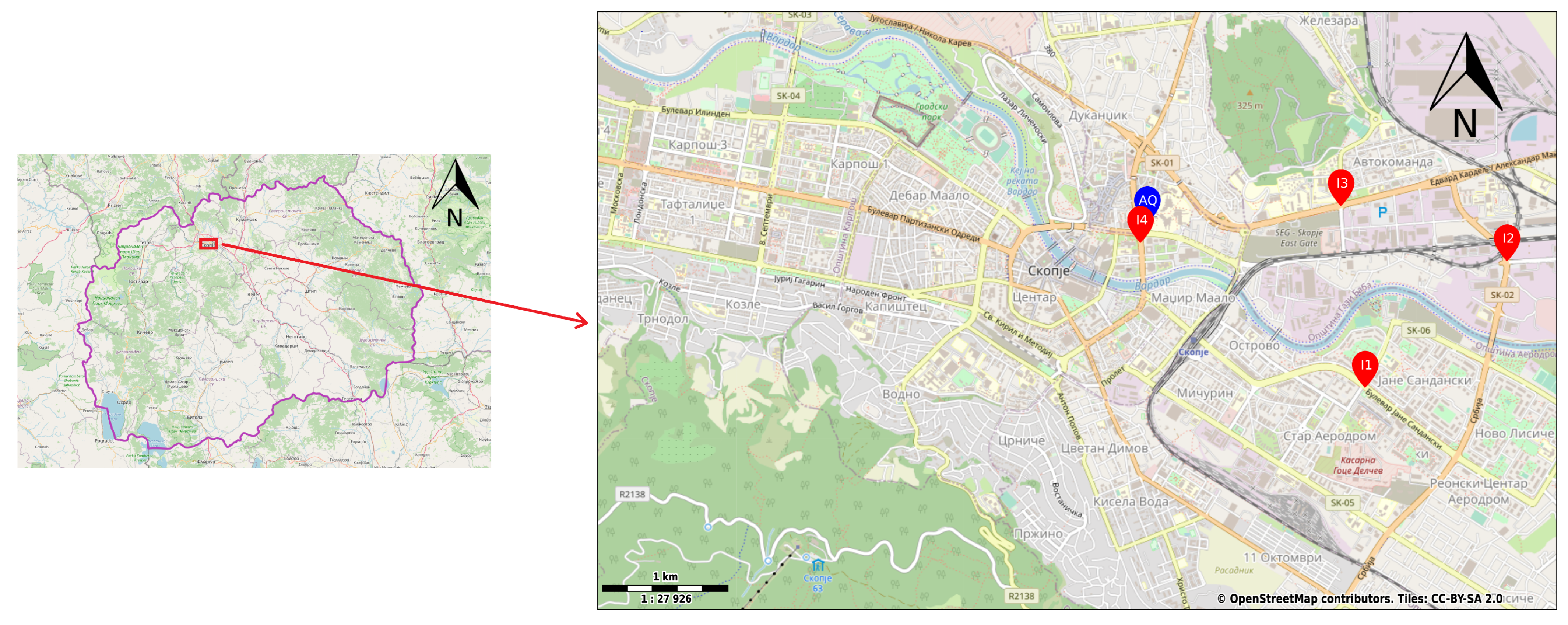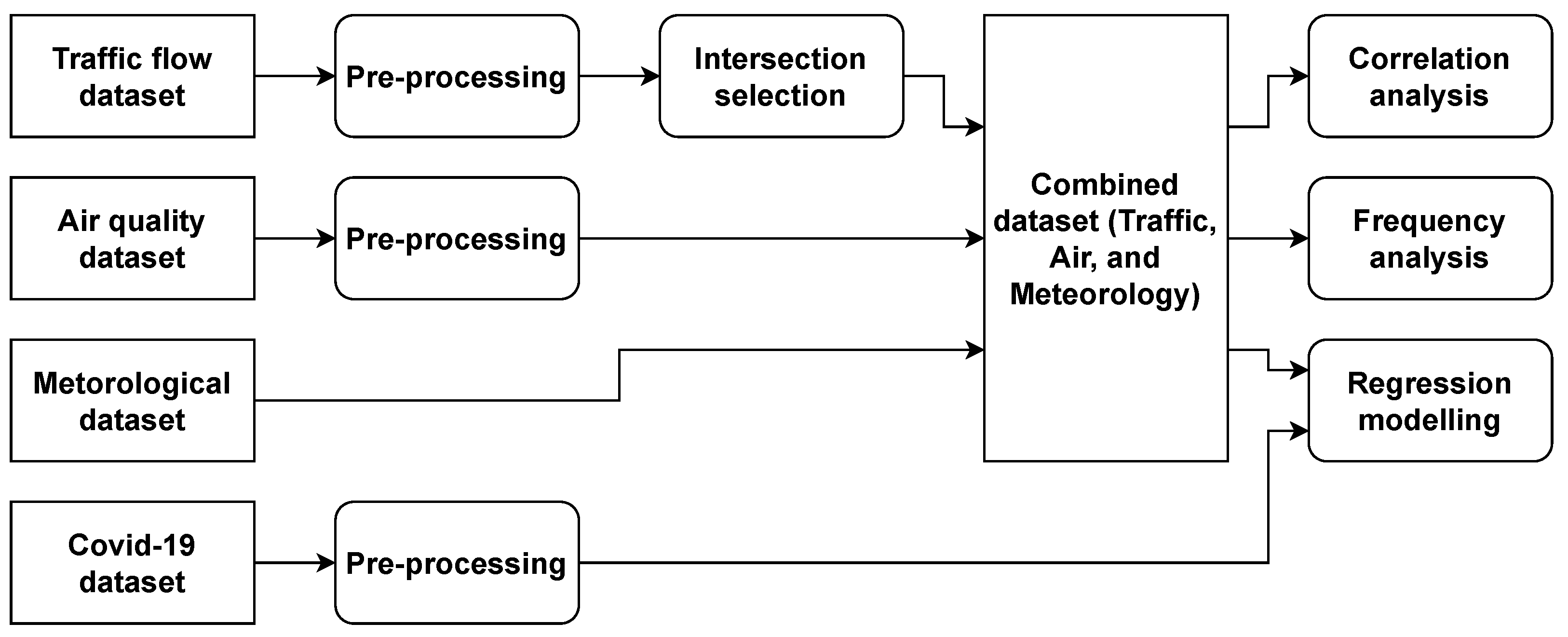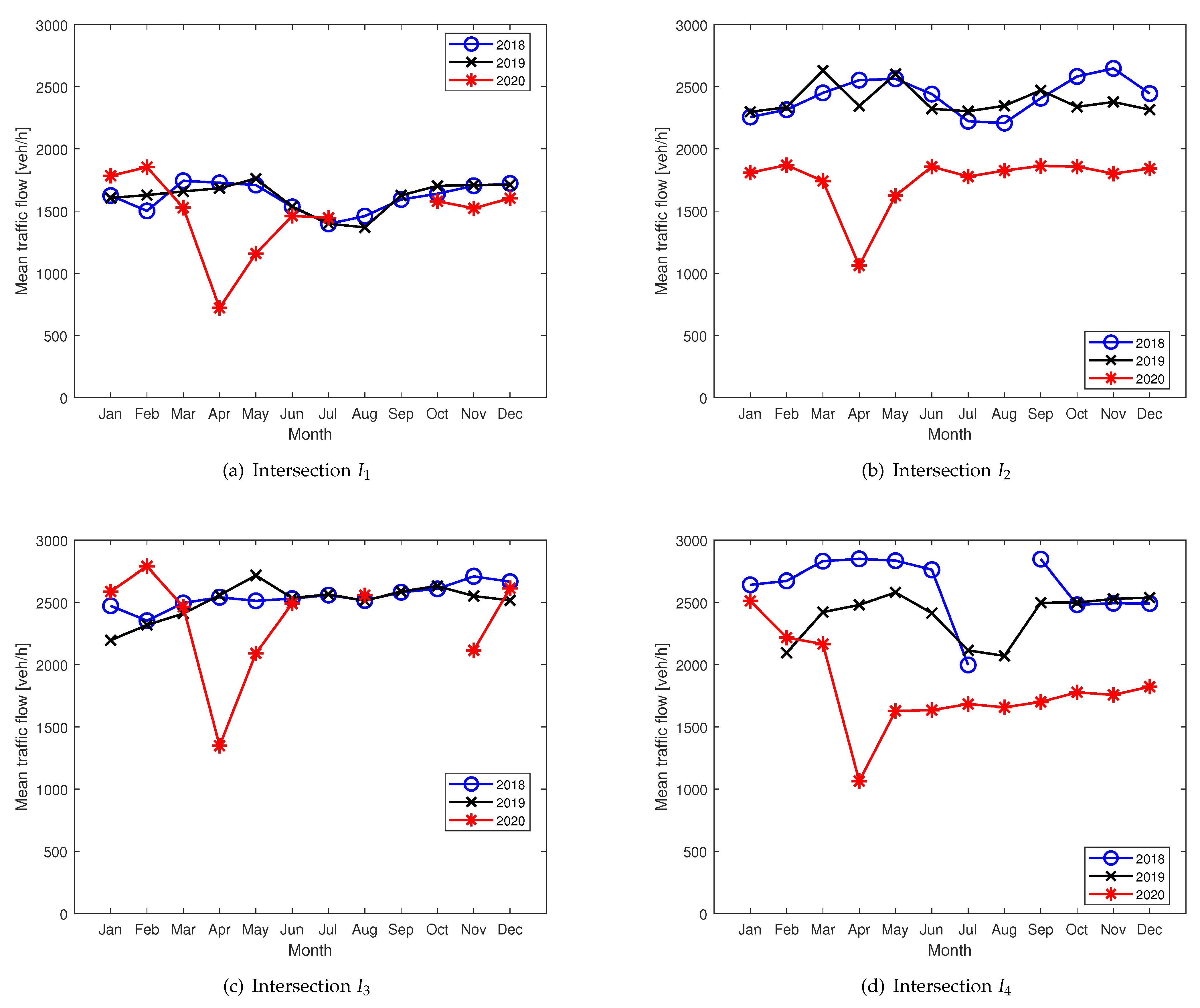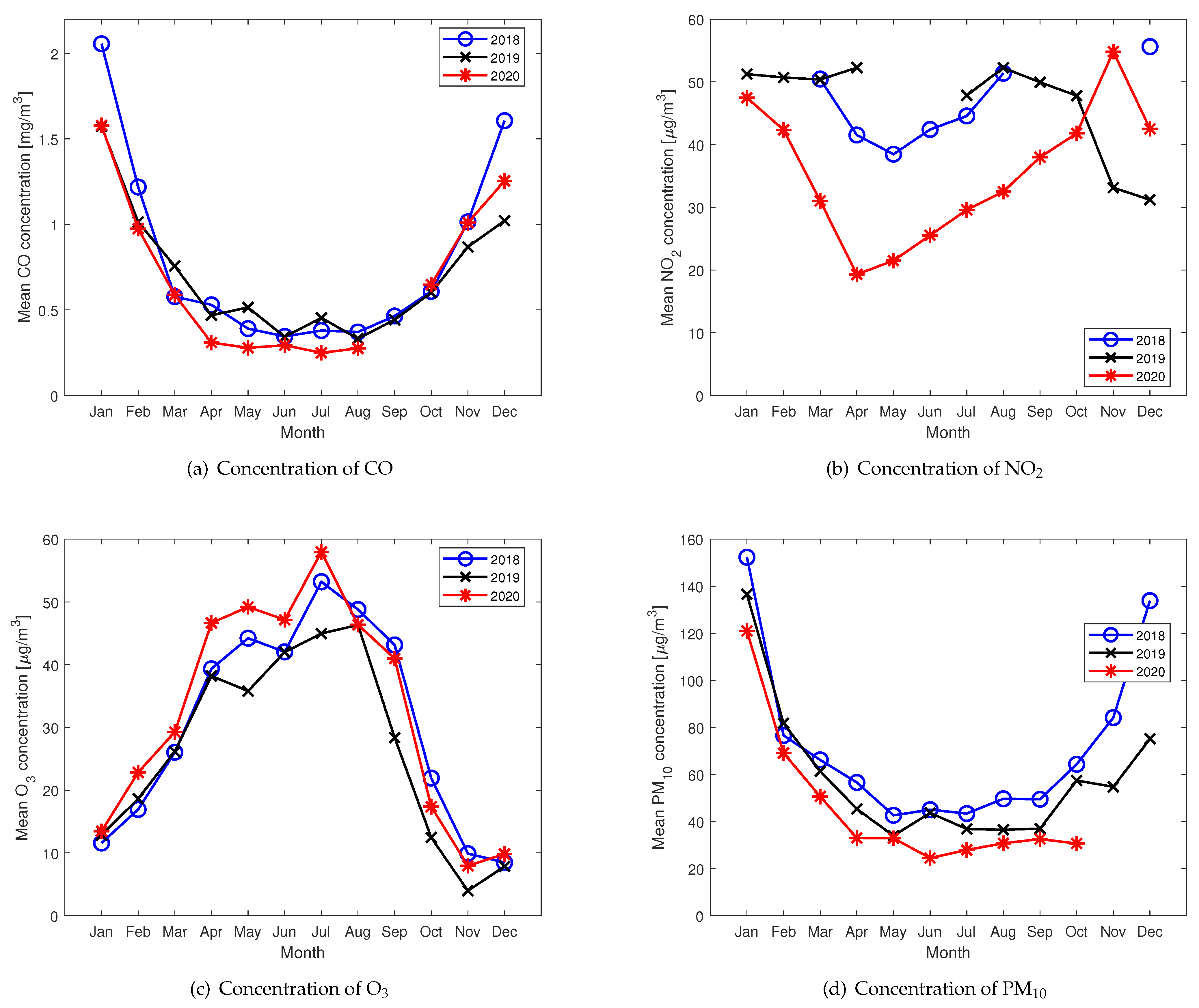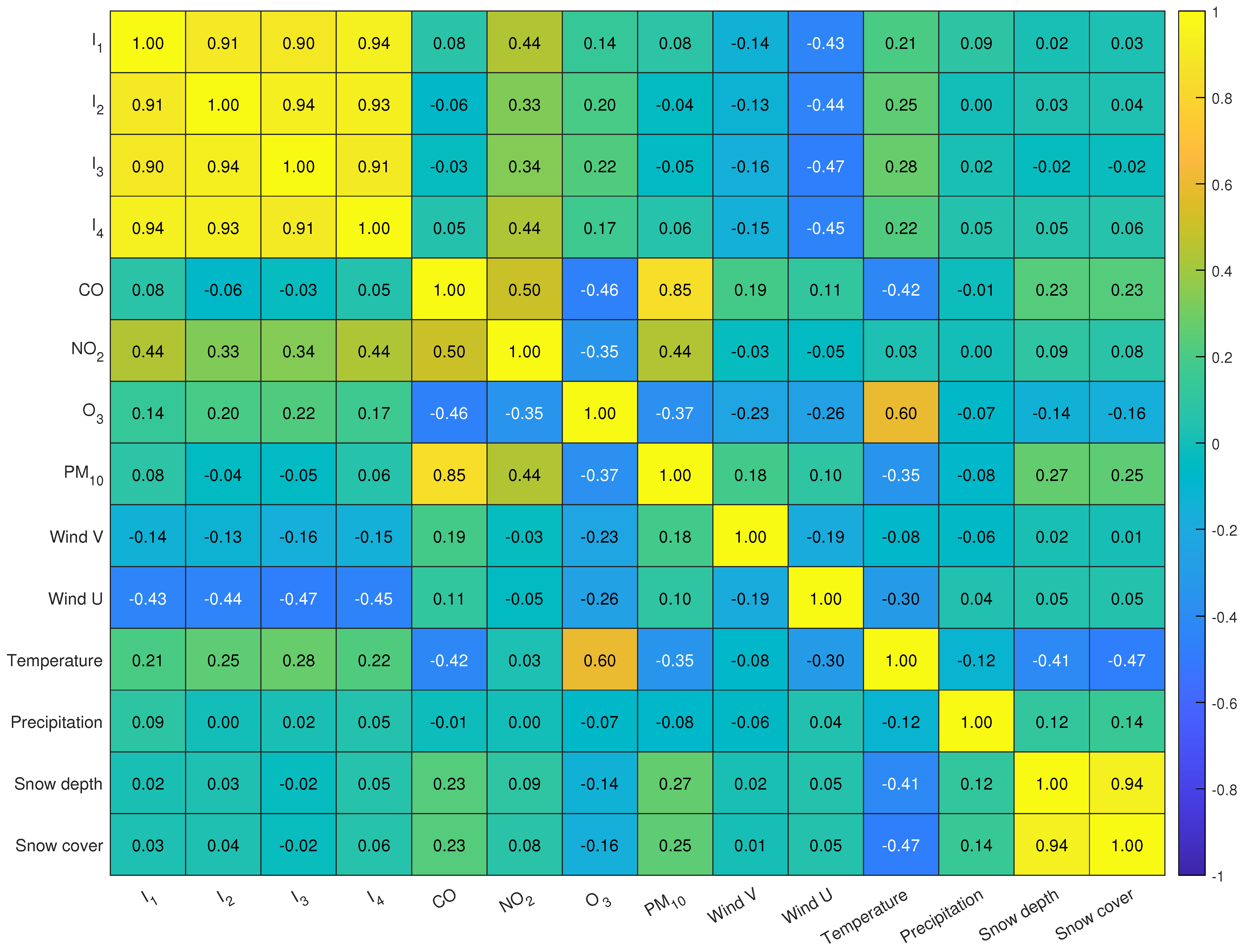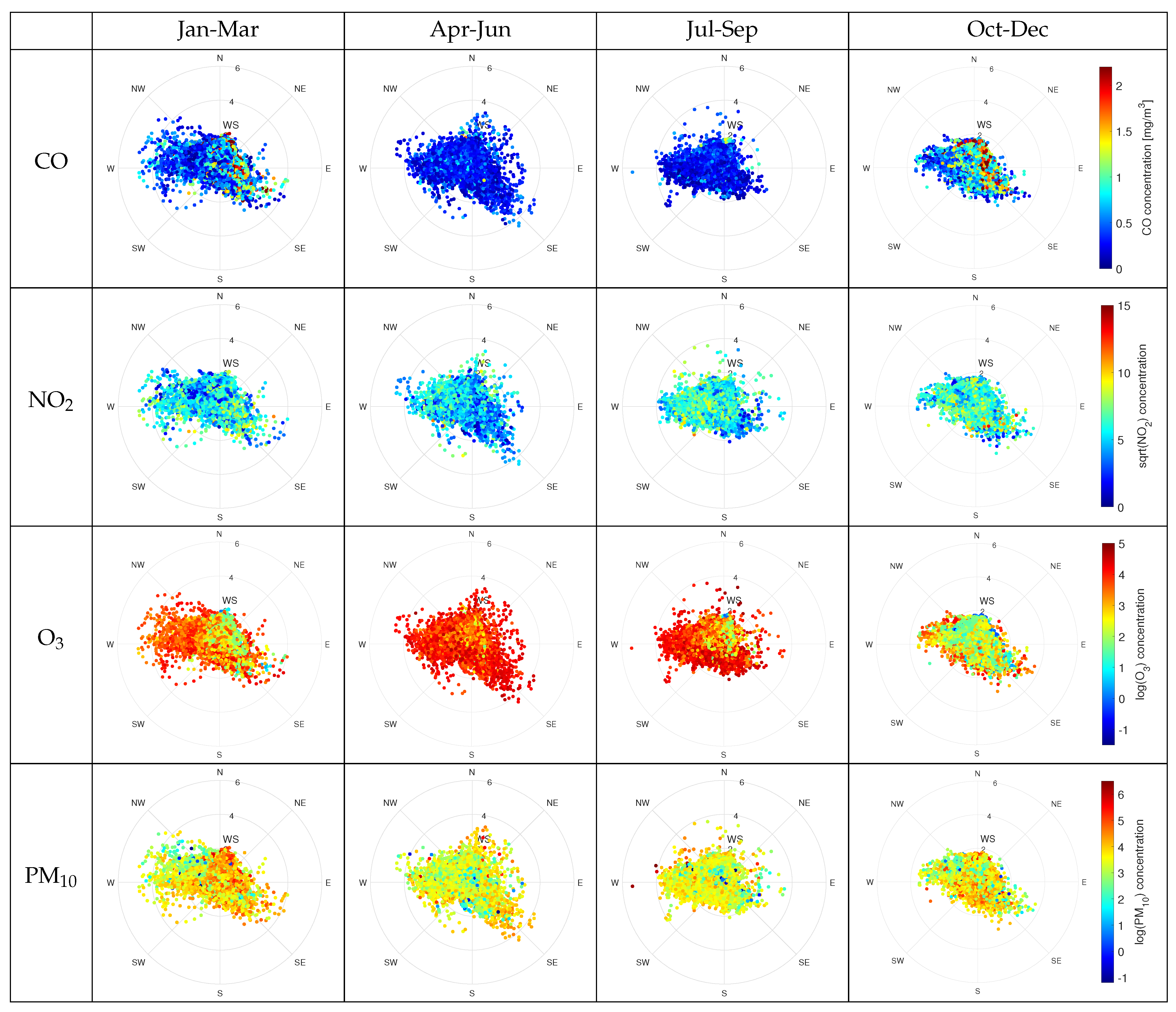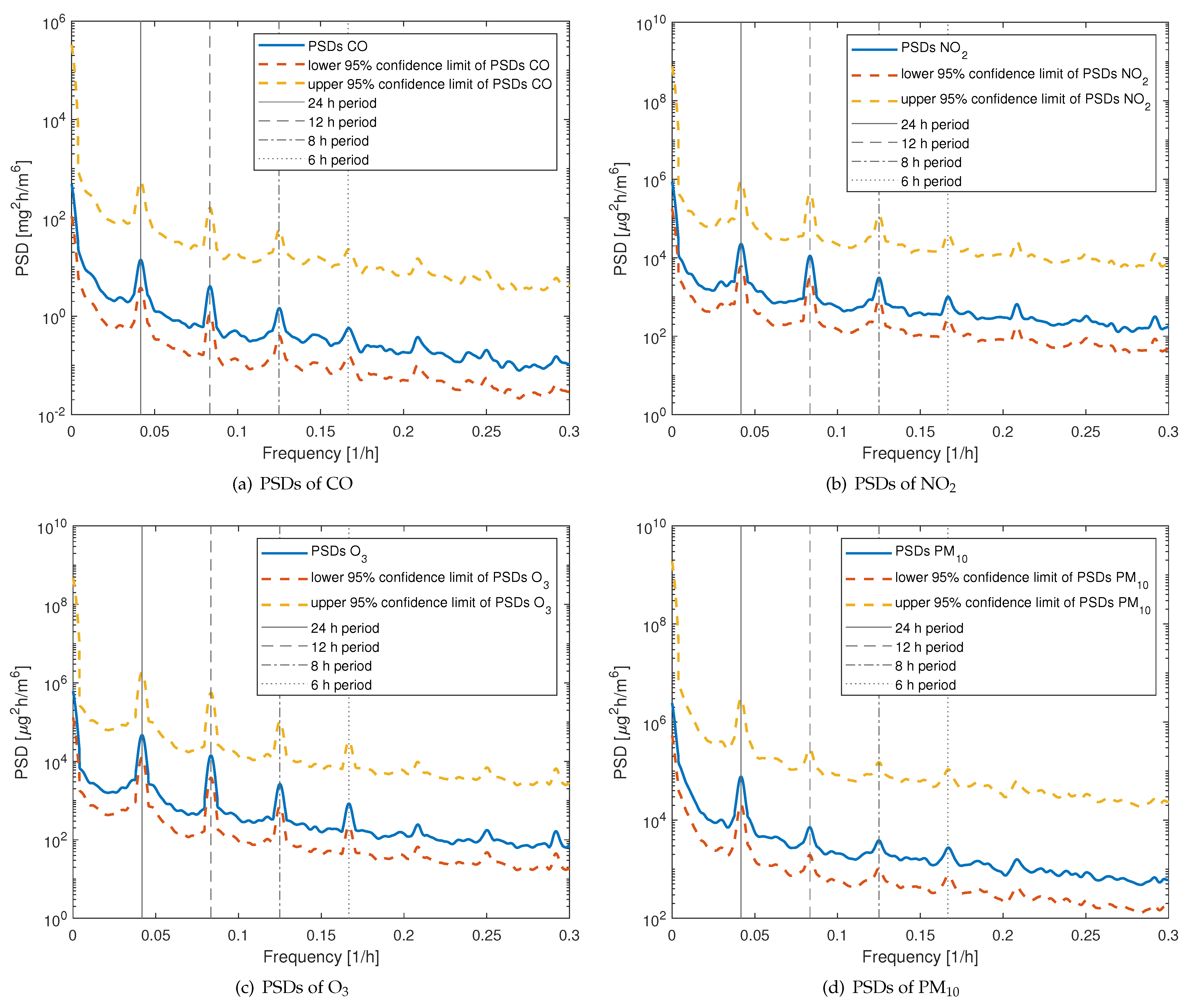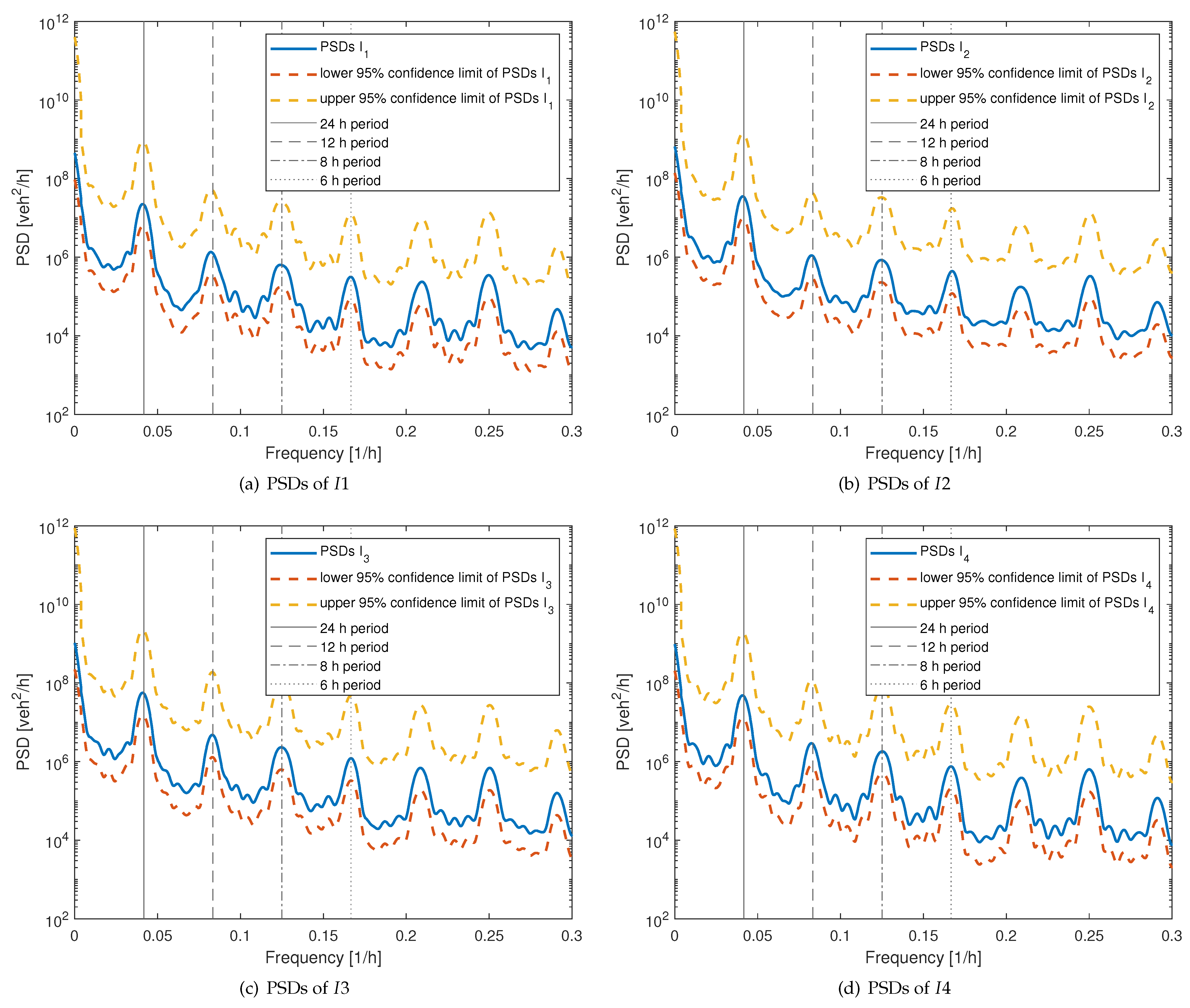1. Introduction
The mobility of goods and people is one of the major contributors to the development and prosperity of urban areas. In countries without developed sustainable public transport infrastructure, most people commute by using private vehicles, thereby causing increased levels of congestion. With increased congestion, vehicles spend more time in intersection queues with their engines turned on and emitting pollutants. With increasing pollution levels, the air quality and living conditions continuously degrade. Obvious solutions to this growing problem are investment in sustainable modes of public transport, switching to alternative fuels, and improving the existing transport infrastructure. Unfortunately, it is challenging to persuade both the public and regulatory officials to act on this matter. One obstacle is the difficulty in estimating the actual amount of air pollutants that are directly caused by traffic, as multiple other factors, such as industry and meteorological conditions, can affect the measured pollution levels. With proper assessment of traffic-induced air quality degradation, future sustainable mobility concepts can be developed. With the identification of key problem areas or problematic time intervals, possible solutions will be easier to develop.
Since the year 2019, a global pandemic of the severe acute respiratory syndrome coronavirus 2 (SARS-CoV-2) causing the coronavirus disease of 2019 (COVID-19) has severely affected all industrial and social elements of human life. Various restrictive measures have been imposed to differing degrees throughout the world to deal with the pandemic. The imposed measures range from simple recommendations to increase hygiene levels to even full national lockdowns and restrictions on movement and mobility. The full impact of both the pandemic and the imposed measures is yet to be determined, but the effect of restrictive measures on air quality in urban areas can be analyzed. This took place in the city of Skopje, North Macedonia, using existing traffic and air-quality-measurement instruments, and with highly restrictive measures on mobility. The main goal and research objective of this paper is to model air pollution with respect to traffic flow and meteorological conditions. A research question arose on how the COVID-19-related restrictive measures impacted the air quality and what their impact was on the model’s coefficients.
This paper is comprised of six sections. After the introductory section, the relevant literature is reviewed in section two. Section three explains the methodology and data used for processing, correlation, and regression analysis. In section four, the results are presented, followed by a discussion in section five. The final section concludes the paper with a commentary on possible improvements and future work.
2. Literature Review
In the available literature, the transport sector has long been associated with rising air pollution in urban areas [
1]. The chemical properties of internal combustion engines are to blame for rising CO and
levels, as those gasses are byproducts of their general operation. In addition, a lot of particulate matter (PM) has also been attributed to the transport sector. Many adverse health effects are attributed to rising air pollution levels, such as respiratory problems, cardiovascular health decline, and even cancer [
2]. The technological and technical development of engines eventually allowed reduced emissions, but it remains unlikely that the zero emissions goal will ever be met while combustion engines are in operation [
3]. With increasing norms and regulations in developed countries, a switch toward the electrification of transport has started [
4]. Unfortunately, developing countries are not only slow to introduce electric vehicles, but also, the vehicles in those countries tend to be older, generating increased emissions.
The city of Skopje, the capital of North Macedonia, which is a developing country, is known for high levels of air pollution. Multiple studies on air quality in Skopje have been conducted supporting this situation. The research in [
5] identified air pollution as a major environmental health problem in Skopje. In addition to health problems, the economic and social costs of pollution were also considered to be very high. Studies of Skopje air pollution [
5,
6,
7] identified two key components of pollution in Skopje. The first component is the human influence in the form of heavily congested traffic flow, residential heating systems, and industrial activity in the city. The second component is the geographical nature, since the city is located in a river-shaped valley surrounded by mountains. This has the side-effects of a low wind speed, high humidity during winter, and temperature inversions which trap air pollutants in the city.
Since the start of the COVID-19 pandemic, the lockdown’s effects on air pollution have been closely monitored by researchers. The impact of COVID-19 measures in Qatar was discussed in [
8], and it was observed that overall, the traffic demand was reduced by
while measures were active. Side-effects of this reduction the reductions in traffic violations and crashes, by
and
, respectively. In [
9], the impact of COVID-19 measures on air quality in Almaty, Kazakhstan, was analyzed. The paper noted that there were substantial reductions in CO, PM
, and NO
concentrations during the lockdown. However, it is noted that even in traffic-free conditions, during the lockdown, the overall air quality remained low, as there were many other sources of pollution in the city. In [
10], the authors discussed a comprehensive study of private vehicle restrictions policies in 49 cities in China. A noticeable effect on air pollution was observed, and it is discussed that policies implemented for COVID-19 spread reduction could also be implemented for the purpose of air pollution improvement. The research in [
11] observed reductions in congestion, mobility, and NO
during the lockdown across 22 US cities using regression models. The research was also conducted in smaller cities, as reported in [
12], where the city of Maribor, Slovenia, was observed during COVID-19 lockdowns. It was reported that the reduction in NO
was smaller than the reduction in traffic volume due to a shift to more NO
-dominant traffic sources, such as diesel-powered heavy-goods vehicles, which remained in operation even during the lockdown. A study in [
13], which also focused on the city of Maribor, observed a similar reduction in PM particle concentration.
In the available literature, only two papers focused on the effects of COVID-19 measures on air quality in Skopje. The first paper [
14] provides an early analysis of air quality state following the most restrictive part of 2020’s COVID-19 measures. The results show that there was an reduction in air pollution during the lockdown period, but there is no direct comparison with traffic and meteorological data. The second paper [
15] analyzed the impact of COVID-19 measures in Skopje on noise pollution levels, observing reductions. The reduced noise levels were in part caused by the reduced road traffic, but a direct correlation or further analysis was not provided.
A systematic review of COVID-19 measures on air quality presented in [
16] revealed that in most study areas around the world, there was a general improvement in air quality during the imposed lockdowns. In general, it was observed that the values of NO
and PM
concentrations decreased significantly. The value of O
concentration usually showed a small increase. The CO levels were more diverse, depending on the study location. In [
16], the authors also identified that more studies are needed, as each study location had a unique combination of policies, meteorological conditions, geography, and air pollution levels. In addition, an analysis of the imposed restrictions impact on air quality beyond the first lockdown should be conducted.
Considering the literature review above, several research gaps were found that are addressed in this paper. The first identified research gap is that most research on the impact of COVID-19 on air quality has focused on brief periods of strict lockdowns, usually at the beginning of 2020. Our study included data from two years before COVID-19 and the entirety of 2020. The second identified research gap is that there has been no analysis of how regression models, frequently used in periods before COVID-19 to model the relation of traffic and air pollution, were affected by COVID-19. In our study, a comparison is made between regression models created from data before COVID-19 measures and after. The main contribution of this paper is the analysis of the correlation between air quality and traffic flow, with a special emphasis on outlier behavior caused by COVID-19-related restrictive measures using real data collected in the city of Skopje, North Macedonia. For the analysis, the traffic, air quality, and meteorological data were collected from the beginning of 2018 until the end of 2020. While this paper deals with the impacts of COVID-19 measures on traffic and air quality, it should be noted that other effects of COVID-19 measures (political, economic, and social) are beyond the scope of this paper and will not be discussed.
5. Discussion
Results of the ln(CO) regression models given in
Table 7 show that all models were significant, having
p-values well below
. Since time-series data such as pollution measurements are usually subject to the autoregression of residuals, it is difficult to trust the obtained
p-values. Models 4–6 included the AR component, resulting in much higher
values. In those models, the residuals were no longer autocorrelated, and instead followed a normal distribution. Hence, the models are considered significant. By looking at the obtained regression coefficients and associated
p-values of each component, it can be observed that the precipitation component was not significant in all models except model 2, where it barely passed the significance test. All other components were confirmed to be significant, except the U wind component in model 4. It was observed that the coefficient of traffic was positive and significant in all models. This observation suggests that traffic does have an impact on the CO concentration. However, air temperature has the strongest influence on CO concentration, which is to be expected, considering the strong negative correlation between air temperature and CO concentration. The interpretation of this result nevertheless remains difficult, as the effect of temperature on CO concentration is not direct. It is the opinion of the authors that for the given case study, the following factors connect the air temperature and CO concentration:
Heating systems’ activation during colder periods;
Formation of inversion layers above the urban areas during colder periods;
Idling of vehicles with the engine running for defrosting and heating.
Since the factors mentioned above are difficult to measure, and their negative correlation with temperature was expected, the authors deem the inclusion of temperature in the regression model appropriate. It is observed that the value is somewhat higher for models with data only from 2020, but the regression coefficients differ only slightly. Since the coefficients are similar in all models, it is the opinion of the authors that periods with restrictive COVID-19 measures did not create an outlier.
Considering the results of the sqrt(NO
) regression models shown in
Table 8, similar conclusions in regard to autoregression of residuals can be made as in ln(CO) models. The primary concern with the sqrt(NO
) models is a large amount of missing data, especially in years 2018–2019, as can be seen in
Figure 4b. The
p-values of the sqrt(NO
) model components show that precipitation does not seem to be a significant factor in the model. For models 7 and 10, the
p-values of coefficients show that air temperature and precipitation are not significant. In all sqrt(NO
) models, the traffic component is significant and positive. The impact of COVID-19 measures on NO
pollution seems evident, as a large drop in NO
levels as found for the same time as most restrictive curfews were imposed. The obtained regression models also support this, as no outliers were identified in periods with restrictive COVID-19 measures. However, a direct comparison between the years 2020 and 2018–2019 was difficult, due to missing data.
In the correlation analysis, there was a high positive correlation between CO and PM
concentrations. This correlation is high, since both CO and PM
share strong yearly periodicity. This high correlation might imply that similar regression models could be used to model both CO and PM
concentrations. From the results of ln(PM
) regression models in
Table 9, it is evident that models’ performance levels considering
were lower than in the case of ln(CO) models. The traffic component was significant and positive in all ln(PM
) models. Unlike the ln(CO) and sqrt(NO
) regression models, the precipitation component remained significant in all ln(PM
) models. The negative coefficient of precipitation implies that the presence of rain decreases the concentration of PM
particles in the air. The impact of COVID-19 measures is not significant in regard to PM
concentration. This is attributed to the fact that many external sources of PM
other than vehicle emissions are located in the vicinity of Skopje.
The results of COVID-19’s influence on air pollution mostly comply with other research on this topic summarized in [
16]. In most case studies, the immediate effect was observed in the reductions in NO
and
levels and a smaller increase in O
. In this research the effect was only noticed for NO
and O
, and PM
levels showed only a small decrease.
6. Conclusions
In this paper, air pollution in urban areas was modeled using linear regression. The research was conducted as a case study in the city of Skopje, North Macedonia. Collected traffic, air quality, and meteorological data were used to create a regression model of ln(CO), sqrt(NO), and ln(PM) concentrations. The traffic component was found to be significant in all regression models with a positive coefficient. However, the impact of traffic on air pollution was strong only in terms of NO concentration and low for CO and PM due to strong seasonal influence. Additionally, the impact of COVID-19-related restrictive measures was analyzed. The results show that a significant drop in NO concentration coincided with the imposed curfews and bans on human mobility. The values of CO and PM did not change significantly during COVID-19 restrictions, indicating that traffic is not the primary source of CO and PM emissions. Finally, to answer the main research question, it can be concluded that COVID-19-related restrictive measures did not create an outlier in the regression model and that the regression coefficients mostly remained the same. From the results, several policy recommendations arise for the identified stakeholders. For governing officials, the primary concern should be high levels of air pollution, especially in winter periods. Incentives should be made to reduce unnecessary road traffic and to switch to newer vehicles, which have reduced emissions. However, it is also evident that a large contributor to pollution is the industry located in the city. In the short term, modernization of industry could provide large benefits to reduced air pollution. In the long term, the industrial sector should be separated from the city to a less-populated area. The primary limitation of this research was the resolution of the observed data variables, and there were many missing values, particularly for intersection data, since only a week of data were available for each month. Adding more air-quality-measurement stations throughout the city would greatly improve the results and allow for spatial analysis of data. The regression models could be improved by including more variables, such as air pressure, as it could explain some of the variability in air pollution data. The COVID-19 measures provided a unique opportunity to observe how the sudden reduction of traffic might affect air quality. For the city of Skopje, however, the primary pollutants are not the vehicles, but instead, possibly the steel processing plant and power plant located in the city. Future work on this topic should include the collected traffic and pollution data for years following the COVID-19 pandemic.
